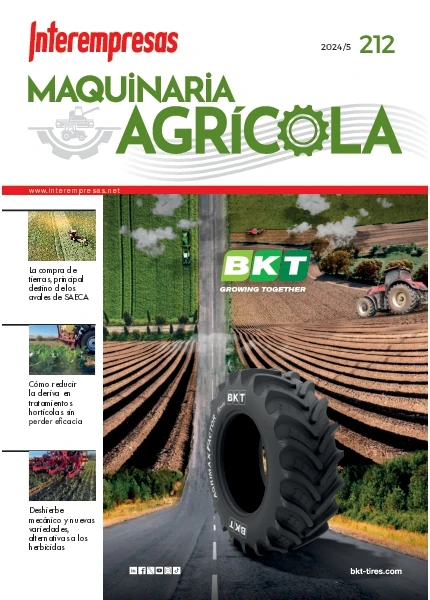Desinfectantes Used in the alimentary industry
Juan José Canet gascó, deputy director of the Department of Services to the Customer; Enrique Orihuel Iranzo, adviser delegated, and Ramón Bertó Navarro, director of Operations of
The disinfection of the surfaces and environingingments in the alimentary industry is fundamental to guarantee the inocuidad of the foods, avoid that they can cause toxiinfecciones alimentary and achieve a greater commercial life of the product. All the equipment and utensils of the zones of work have to be disinfected to ensure that they reach some sufficient hygienic conditions to attain this aim. Thus, it is important to know the active matters biocidas available and the different products formulated with them, as well as his characteristics and suitability of application in each concrete case.
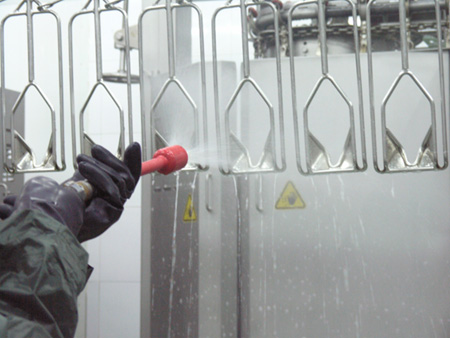
Introduction
The action biocida of the desinfectantes on the surfaces of the alimentary industry is influenced by numerous factors, like time of contact, temperature of application, concentration, superficial tension of the solution desinfectante, pH, number and location of the microorganisms or type of objective microorganism. In the practice, in addition to the factors enumerated, also influences enormously the efficiency of the phase of previous cleaning, in the separation of the organic and inorganic dirt of the surfaces of work that have to be disinfected. The action of the detergents has to achieve the separation of the dirt and of big part of the microorganisms of the surfaces.
The fact that a microorganism was separated of his support increases the surface of contact with the desinfectante, and increases his efficiency biocida. In case alone, the cleaning is able to delete 80% of the microbial load, the disinfection of the surfaces has to achieve a reduction of the microbial pollution of around 95%. It does not have to confuse disinfection with sterilisation, this last can achieve reductions of 99,999%.
The desinfectante has like aim attack to the vital elements of the microorganism, attain his destruction and, therefore, cause the lisis of the cell. In the alimentary industry, has to achieve the elimination of the pathogenic microorganisms, and the reduction until acceptable considered levels of the microorganisms alterantes.
The classification of the desinfectantes is based, essentially, in the active matter biocida with which formulate . In occasions, in a same formulation can find two active matters, for example, exist desinfectantes that combine glutaraldehido with quaternary ammoniums, like the Dectocide SB5 developed by Betelgeux; or peroxide of hydrogen and sour peracético, like the Betelene OX150.
Types of microorganisms of interest in the alimentary industry
Before developing a plan of disinfection is convenient to define the type of microorganisms on which wishes act, to warn or reduce his presence in the surfaces, environingingments and installations of the rooms of work. In a lot of cases, the desinfectante has to exert his action on more than a type of microorganism.
In the alimentary industry is possible to find four microbial groups that they can cause toxiinfecciones in the consumers:
- Molds and yeasts
- Micobacterias
- Virus (encapsulados or no)
- Bacteria (Gram +, Gram – and in shape esporulada).
Each one of these groups of microorganisms has specific biological characteristics that influence on his capacity to adapt to the presence of agents desinfectantes.
The microorganisms: bacteria, micoplasmas, molds and virus are wrapped by a cytoplasmic membrane. This membrane delimits to the microorganism of the half external, and has big importance in the molecular exchanges between the interior of the cell and the outside, in addition to exerting a protective effect of the same.
The cytoplasmic membrane is composed, fundamentally, by a double layer lipídica in which they insert proteins, and is formed by phospholipids. In the central part of the bicapa of lipids finds a zone hidrófoba and in the periphery presents a part hidrófila. These characteristics influence on the resistance to the active principles biocidas.
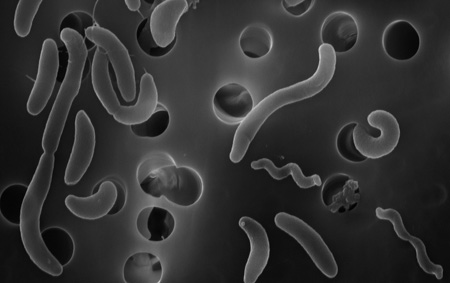
Characteristics of the microorganisms
Bacteria Gram + and Gram –
The bacteria have capacity of sintetizar a wall attaches to the cytoplasmic membrane. This wall presents differences between distinct types of bacteria and allows to differentiate them in bacteria Gram + and bacteria Gram -. A first difference between them appreciates when comparing the thickness of the wall in both types of bacteria, in the bacteria Gram +, as in Estafilococos aureus, the thickness oscillates between 20-80 nm; whereas in bacteria Gram -, as Escherichia coli, his thickness oscillates between 10-15 nm. However, the wall of the bacteria Gram – is more complex that the ones of the bacteria Gram +. This greater complexity provides to the wall a greater degree of impermeabilidad to the substances, except for those that they can penetrate by the pores of the cells. Therefore, the bacteria Gram – are less sensitive to the desinfectantes that the bacteria Gram +.
Besides, some bacteria, as Bacillus spp and Clostridios spp, are able to form spores when the half that wraps them is them hostile. The spores constitute, in this way, a half of resistance of the bacteria to the antimicrobic agents, and can cause pollutions of the foods, resist the thermal sensors treatments or of conservation and ocasionar toxiinfección alimentary, since when the conditions are favourable can go back to the vegetative state with his initial characteristics and have the possibility to multiply again.
Molds and yeasts
The yeasts are microscopic funguses, generally, unicellular. They can cause allergies and in some cases infections sistémicas. His cellular wall is formed by a skeleton of chitin that protects it of the physical aggressions-chemical
The molds are microscopic funguses, presents mainly in humid means. The main problems of health that ocasionan are been due to the volatile organic compounds that produce, the micotoxinas, and the pollution of the air by spores that can be inhaled. So much the molds like the yeasts possess a resistance to the compounds biocidas intermediate between the bacteria Gram + and the bacteria Gram -.
Virus
In the viruses, his membrane is formed fundamentally by proteins. A first distinction between the viruses is based in the presence or no of a wrapping lipídica. Those that possess it designate virus encapsulados, in front of the viruses no encapsulados that they lack this wrapping. Paradoxically, the resistance to the active matters biocidas is greater in the viruses no encapsulados, as the chemical agents alter the wrapping lipídica and goes back them more sensitive to his action. The viruses no encapsulados adapt better to the desinfectantes when lacking this wrapping, be physiological and morphologically simpler, and therefore more flexible.
Micobacterias
The micobacterias are organisms ubicuos that can find in the earth, waters, foods, in the surface of floors and machinery. Some are very known, like the Mycobacterium tuberculosis, causante of the tuberculosis. The micobacterias, in addition to possessing a complex wall, produce a wall of nature cérea, that provides big resistance to the desiccation, and therefore the possibility to survive in the environingingment during years, in addition to increasing his resistance to the desinfectantes.
Factors of resistance of the microorganisms to the desinfectantes
The factor of greater incidence in the resistance of the microorganisms to the active matters biocidas is the composition of the cellular wall. This resistance has an innate character and determines the spectrum of activity of the desinfectantes. In function of the morphological characteristics of the microorganisms, described in the previous point, each microbial group reacts of distinct way to the desinfectantes. Russel (1997) studies this difference between different microorganisms, observing that the viruses encapsulados are very sensitive to the desinfectantes, whereas the spores are extremely resistant. After the viruses encapsulados, the greater sensitivity is, by this order, for the bacteria Gram +, molds, bacteria Gram -, virus no encapsulados, and micobacterias.
In addition to the innate resistance in function of the morphological factors, the microorganisms can develop resistance to the products biocidas, designated resistance purchased. The incidence of this type of resistance to the desinfectantes is very inferior to which presents in front of the antibiotics, due to the fact that the antimicrobic activity that realizar these last exerts on an objective zone of the cell, whereas the action biocida of the desinfectantes is more diffuse and can not signal an only point of performance, what minimises in some way the presence of resistant microorganisms to the active principles desinfectantes.
The resistance purchased is the result of a change to level of the genome, that causes a mutation and back selection of the microorganisms by the desinfectante, that is to say, produces a natural selection of the microorganisms that have purchased the new genetic character. A spontaneous mutation to level of a chromosome can award to an organism a character that provide him resistance to an active matter biocida, later, when multiplying transmits the gene of the resistance, this character will be increasingly dominant in the present population in the industry, whenever it effect the disinfection of his installations with the same active principle, and go deleting the microorganisms that do not possess the mutation.
The modifications in the genetic material that allow to the microorganisms adapt, act to distinct levels: production of new resistant enzymes, changes in the internal structure of the cell, modification of the permeability of the cytoplasmic membrane and modification of the structure of the cellular wall. These changes produce an increase of the resistance of the microorganisms, to the usual concentrations of employment of the desinfectantes. In occasions, besides, a decrease of the doses used of the product desinfectante can comport a greater survival of the bacteria. In this sense, has showed that the systematic utilisation of concentrations subletales of desinfectantes can improve this problem (Underwood et al, 2007), facilitating in some cases the learning of spores.
With the aim to keep an effective concentration of the desinfectante, is important to correct the causes that can diminish his efficiency: presence of organic matter and dirt on the surfaces to treat, the caducity of the product (ej. Clorados) With the consequent loss of concentration and efficiency, reduced time of performance before the final rinse, use the doses recommended by the manufacturer, monitor periodically the real doses applied, etc. All this justifies, in occasions, the need to effect rotations between the desinfectantes with distinct active matters.
To continuation does a review of active matters that use in the formulation of the desinfectantes, and his way of action on the microorganisms.
Types of desinfectantes and action in front of the microorganisms
Desinfectantes clorados
The action microbiocida realizar it the chlorine, that is a gas that can not use in the formulation of the compounds, thus a half to use it is by means of the reaction with caustic products, what gives place to the learning of hipoclorito of sodium, that is the base of numerous desinfectantes (Betelchlor 35, Betelchlor 65, Betelchlor 55 EC). His can desinfectante comes from of his properties oxidants because of the presence of the ion ClO-, that attacks the cytoplasmic membrane. The hipoclorito of sodium NaClO is a salt of the acid hipocloroso HOCl. In solution, the hipoclorito of sodium disocia in ions sodium Na+ and ClO-.
The form biocida more effective, the acid hipocloroso (HOCl), needs the addition of an atom of hydrogen (H) that takes of the water. To preserve his efficiency biocida is necessary to keep the humid surfaces, as to measure that these dry , the water disappears, and the reaction displaces to the less effective form (OCl-). Thus, it is necessary to conserve the humid surfaces during the time of planned contact to attain the maximum efficiency biocida and esporicida, in contrary case will not produce more than sequipment of chlorine, without the effect desinfectante wished. The desinfectantes clorados are effective in front of all the vegetative bacteria, virus, and, to greater concentrations, spores bacterianas, yeasts and molds.
The main advantage of the products clorados is his low cost and that possess a wide rank of performance in front of the microorganisms. They are effective to low temperature and, generally, do not have residual activity. His main disadvantage is his unsteadiness, so much in front of the environingingmental conditions (light and heat) as in presence of organic matter, inconvenient that tries minimise in the formulated desinfectantes.
Glutaraldehido
The products formulated with glutaraldehido (Dectocide GOES15, Dectocide SB5) are biocidas of wide spectrum, with efficiency in front of bacteria, molds, virus, and also in front of micobacterias; besides, when the solution is alcaline (pH 7,5 to 8,5) active and possesses activity esporicida. They act by means of the alquilación of the chemical groups of the proteins and nucleic acids of the bacteria, virus and funguses. The glutaraldehido acts on the proteins by desnaturalización, and on the nucleic acids and the proteins by alquilación. To level of the nucleic acids, the reaction is irreversible. On the cellular wall, the glutaraldehído acts to level of the bridges crossed of the peptidoglicano. The reaction with nucleotides receptivos takes place quickly and the balance bends to the hidroximetilación.

Salts of quaternary ammoniums
The products of reaction of the tertiary amines with halides of rent know with the name of salts of quaternary ammonium. These compounds have four atoms of carbon joined to a nitrogen by means of covalent links or three atoms of carbon of which one of them is joined to the nitrogen by means of a link of electrostatic nature. When one of the radicals is a chain alquílica fat, these compounds possess character tensioactivo and belong to the group known like “tensioactivos catiónicos”.
The compounds of quaternary ammoniums are bactericidas, fungicidas and virucidas. His activity develop it so much on the half acid like alcaline, although in this last better sample actions. Of the derivatives of the quaternary ammonium, the chloride of benzalconio was the first compound of this type entered in the market, with good activity bactericida (Dexacide B10 is a formulation of Betelgeux based in chloride of benzalconio).
The compounds of quaternary ammonium possess a good activity like detergent and remain active even in presence of hard water. His efficiency biocida achieves by his capacity of penetration in the membranes of the microorganisms thanks to the chains carbonadas (hidrófobas). Through the nitrogen catiónico (hidrófilo) interact with the phosphates of the phospholipids, causing the exit to the outside of the cytoplasmic vital material, also inhibit the respiratory chain and inactivan essential cellular enzymes for the growth, producing the lisis cellular.
The length of the chains alquílicas is determinant of the can microbiocida of a salt of quaternary ammonium. However, the results are not extrapolables of some compounds to others. Whereas, for example, in the chlorides of benzalconio the chains between 14 and 16 atoms are the most effective, in the salts dialquílicas are the chains of less atómos of carbon those that present greater behaviour microbiocida. Synergistic combinations of distinct quaternary ammoniums (like Quacide MC7 formulated by Betelgeux) can increase the activity biocida of the formulated and increase his spectrum of performance.
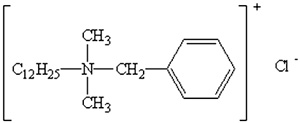
Alcohols
The alcohols have been known from the antiquity and used in Medicine, although the synthesis of the ethanol did not realizar until mediated of the 19th century (1855). His main characteristic, in addition to the antimicrobic, is the one to be good solvents of other products, between them a lot of antisépticos and desinfectantes, improving them in his activity. When increasing the number of carbons increases his antimicrobic efficiency, but also his toxicity, by what only employ the ones of low molecular weight: ethanol or alcohol etílico and isopropanol or alcohol isopropílico. The activity depends on the concentration, but his graphic is a V invested, by what the maximum of efficiency obtain it those that possess a concentration between the 60-80%. The most usual concentrations vary between 70% and 96% for the alcohol etílico and between 70% and 100% for the alcohol isopropílico.
The alcohols possess a fast action, even from the 15 seconds, although they do not have persistent effect, and a wide spectrum of activity, acting on bacteria gram negative and gram positive, including micobacterias, funguses and virus (hepatitis B and HIV). The action microbicida attributes to the entrance through the wall, cellular membrane and with the inactivación of enzymes, by means of break of these barriers and desnaturalización, in the cytoplasm, of essential proteins for the microorganism.
His efficiency is related with the presence of water, this is due to that these aqueous compounds penetrate better in the cells and bacteria allowing like this the damage to the membrane and the fast desnaturalización of the proteins, with the consequent interference with the metabolism and lisis cellular. The alcohols associated to other products like quaternary ammoniums, improve the effect of characteristic action of these compounds, as it occurs in the formulated developed by Betelgeux, Dectocide H21, synergistic combination between quaternary ammoniums and alcohol isopropílico; in some formulations, as Dectocide H24 LB, finds a combination of alcohol isopropílico and food additives.
Peroxide of hydrogen
The peroxide of hydrogen, known also like water oxigenada, is a chemical agent liquid, colourless to temperature acclimatise, with bitter flavour, and that possesses properties antisépticas. The peroxide of hydrogen has effects oxidants for producing OH- and free radicals, which attack to the essential components of the microorganisms like lipids, proteins and DNA. It degrades quickly in oxygen and water, and is an agent oxidant of fleeting effect for being decomposed by the catalases of the cellular fabrics. It is active in front of bacteria and virus, according to the concentration and conditions of utilisation.
Studies “in vitro” of solutions of peroxide of hydrogen to 3% have showed wide spectrum of efficiency, with greater activity in front of bacteria gram positive. In occasions, presents in formulations combined with acid peracético (Betelene OX50 and Betelene OX150), although also it can find only (Betelene Alcox), adding to his character biocida an effect blanqueante of the surfaces, or coadyuvante in alcaline solutions of cleaning in circuits CIP.
Sour peracético
The acid peracético is an antiséptico of type oxidant, mix of acetic acid and peroxide of hydrogen in aqueous solution. It obtains by oxidation from acetaldehído and oxygen in presence of acetate of cobalt. Also it can obtain treating acetic anhydride with peroxide of hydrogen. The activity desinfectante of the acid peracético roots in his capacity oxidant on the external membrane of the bacteria, endosporas and yeasts. The mechanism of oxidation consists in the transfer of electrons of the form oxidada of the acid to the microorganisms, causing like this his inactivación or even his death. It exerts his activity when decomposing in acetic acid, peroxide of hydrogen and oxygen.
To low concentrations (0,1-0,2%) possesses a fast action biocida in front of all the microorganisms. It is active in front of bacteria, funguses, yeasts, endosporas and virus. To inferior concentrations to 100 ppm inhibit and kills to bacteria Gram positive, Gram negative, micobacterias, funguses and yeasts in 5 minutes or less. Some viruses are inactivados by 12-30 ppm in 5 minutes, whereas others require 2.000 ppm during 10-30 minutes. The Minimum Concentration Esporicida (CME) of the acid peracético is of 168-336 ppm (are necessary 1-2 hours of contact). It is more active on the spores when it combines with peroxide of hydrogen. It has showed that the combination of 21 ppm of acid peracético (that it already contains roughly 5% of peroxide of hydrogen in his composition) and 2.813 ppm of peroxide of hydrogen deletes all the microorganisms of porous fibres after 2-3 hours of contact.
Because of his character no espumante, are very used in the disinfection of circuits and enclosed installations. Generally, it presents in formulations with 15% of acid peracético (Betelene OX150) and 5% of acid peracético (Betelene OX50).

Biguanidas polymeric (PHMB)
The biguanidas are active principles that possess a wide spectrum of activity and are very effective in front of Pseudomonas spp, thus it recommends his use, especially, for industries of packaging of water. The mechanism of action of PHMB has been described in numerous articles. It has showed that his maximum activity biocida produces to pH between 5-6, and initially the biocida interacts with the surface of the bacterium, and is transferred to the membrane citroplasmática and the cytoplasm, where reacts with the phospholipids, causing an increase of the permeability, with release of lipopolisacáridos, ions potassium and causes the death of the cell. Betelgeux Uses this active matter in the formulation of desinfectantes, as Quacide P20.
tertiary Amines
they Present a high action mojante, solubilizante and emulsionante. They possess a high spectrum of activity biocida, especially to alcaline pH. His way of action is by means of interaction with the negative loads of the cellular wall, affecting to the so much structural proteins as enzymatic, affects to the metabolic reactions of the cells and alters his permeability causing finally his death. The tertiary amines can formulate beside other active principles, like biguanidas polymeric, achieving a synergistic effect (as in the desinfectante Quacide PQ60 EC), of wide spectrum of performance and that, given his low level of learning of foam, can use in disinfection of circuits and installations CIP.
Sour and álcalis
The alcaline and sour solutions are highly bactericidas. The feeble organic acids, like the acid láctico (used in the formulation of products like Quacide GIVES80 and Betelene SP20), exert a greater effect of the that would be explainable by his pH: the presence of molecules highly permeable and no dissociated promote the penetration of the acid in the cell. The efficiency of the sour and alcaline agents is tied to the concentration of ions H+ and OH-. The ions H+ destroy the amino acids that are linked with the nucleic acids, modify the cytoplasmic pH and precipitate the proteins. The ions OH- saponifican the lipids of the membrane, ocasionando the destruction of the superficial structure. To high pH desorganiza the structure of péptidoglucano and produces the hydrolysis of the nucleotides.
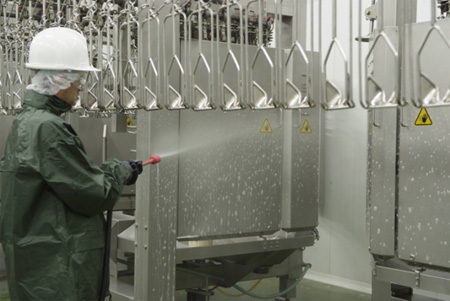
Conclusions
Has realizar a review of the factors that can influence in the disinfection of surfaces and environingingments of the alimentary industry. To practical level, in the industrial application, in addition to the already mentioned parameters, also is important to know determinate appearances that can increase the persistence of the microorganisms in the equipment and installations of the industries, like the learning of biofilms, design of the machinery, rugosidad of the surfaces, etc. Thus, will have to implement protocols that contemplate all these factors with the end to reach the greater degree of possible hygiene that guarantee the hygiene of the foods and his greater commercial life.
Bibliography
- The use of the salts of quaternary ammonium in the alimentary industry. Orihuel, And. Feeding equipment and technology. October 1991.
- Sanitation. Cleaning and Disinfection in the Food Industry. Stanga, M. Wiley-VCH. 2010.
- Cleaning-in-Place: Dairy, Food and Beverage Operations. Third edition. Edited by Tamine, To. And., Blackwell Publinshing. 2008.
- Microbial susceptibility and resistance to biocides. To.D. Russel, James R. Furr, Jean-Yves Courierslard. ASM News, number 63, p. 481-487. 1997.
- Effects of Hospital cleaning agents on spore formation. N American and UK outbreak Clostridium difficile strains. S. Underwood, K. Stephenson, W.N. Fawley, J. Freeman, sports club Baines, R.C. Jr Owens etM.H. Wilcox. The General Infirmary at Leeds & University of Leeds, Or.K., Maine Medical Center, Portland, Or.S. 2007.


